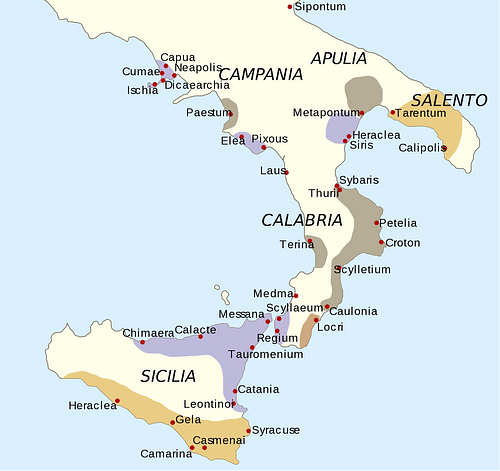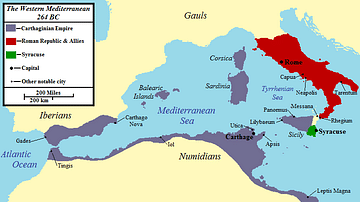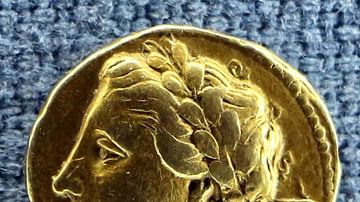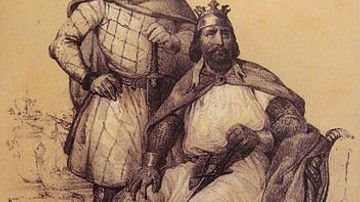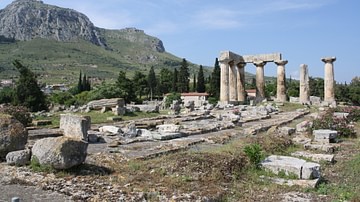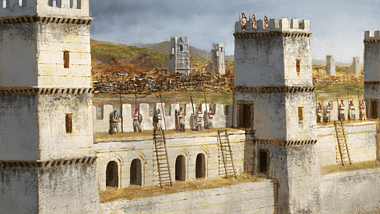
Timoleon (c. 411 - c. 337 BCE) was a Corinthian statesman and general who famously defeated the tyrant of Syracuse Dionysius II and an army of Carthage against the odds. Permanently settling on the island, he re-organized the governments of many Sicilian city-states by giving them political freedom and so set the foundations for a period of sustained prosperity thereafter. He is the subject of one of Plutarch's Lives biographies and ancient writers were remarkably consistent in their unstinting praise for Timoleon the tyrannt-slayer.
Early Life & Career
Timoleon was born in Corinth, and his father was Timodemus and mother Demariste so he grew up in an aristocratic family from both sides. Very little is known of Timoleon's youth or even the first half of his life besides that in c. 368 BCE he fought as a common soldier in the war between Corinth and Argos. Then, still in the mid-360s BCE, Timoleon took the dramatic step of murdering his brother, the power-mad and unpopular Timophanes and so ended his tyranny at Corinth. There is then a gap of two decades during which we know nothing of what Timoleon got up to. Plutarch suggests he withdrew from public life and lived as a hermit in remorse for killing his brother.
Campaign Against Syracuse
When Corinth's former colony Syracuse on Sicily called for assistance in 344 BCE against the dual threat of the tyrant Dionysius II and possible invasion from Carthage, Timoleon was chosen to lead the expedition as general (strategos) and, as one friend said to him, he now had the opportunity to erase his reputation as the killer of his brother and gain glory as a tyrant killer. Things started well, according to Plutarch, when he received a welcome omen on his visit to the oracle at Delphi before setting off where a laurel crown of victory fell from the wall and landed on his head.
Timoleon's force consisted of 700 mercenaries and ten ships which included two ships from another Corinthian colony Corcyra (Corfu) and one from Leucas in the Ionian Sea. Timoleon arrived at Tauromenium (modern Taormina) in 344 BCE and then, in a battle at Adranum, promptly defeated the tyrant of Leontini, Hicetas. When reinforcements arrived Timoleon led an attack on Syracuse itself. He was supported by several Sicilian cities tired of Dionysius' oppressive reign over the region: Adranon, Katane, Tauromenium, and Tyndaris. The campaign was a success and Dionysius II was forced to live in exile back at Corinth. Timoleon even rather generously ensured that the former tyrant had a small allowance to live off in his enforced retirement.
Timoleon Against Carthage
Timoleon was not allowed to enjoy his success for long, though, as an army from Carthage chose this moment of political instability to invade Sicily yet again c. 341 BCE. Still, once more, he received a good omen when before the battle his troops passed some donkeys carrying loads of parsley which Timoloen said indicated the crown of victory just as had happened at Delphi, this time referring to Corinth's long tradition of giving crowns of parsley to victors at the Isthmian Games. The Corinthian general engaged the enemy near the river Crimisus (or Krimisos) in the west of the island and, by attacking first when their force was divided by the river and for a second time during a violent thunderstorm, managed to defeat the Carthaginians despite having a much smaller army at his disposal (6,000 against 70,000 according to Plutarch). Although defeated and having lost over 12,000 men, the Carthaginians could still field a sizeable army and so they hung around to cause trouble, offering their support to various other Sicilian city-states. The result was a bargain between Timoleon and the Carthaginians in 338 BCE which divided up the island into two spheres of influence. He would keep to the eastern half of the island if they stayed in the western part.
Reorganizing & Rejuvenating Sicily
Timoleon then proceeded to systematically take over the government of the various tyrannies in his domain, gave cities a greater level of autonomy, and he established a new constitution at Syracuse. It is not clear what exactly the form of government was in the latter city. Suggestions of a democracy do not match the history of Corinth which had never had such a system. Certainly, Timoleon gave himself extensive powers and perhaps ruled as a benevolent autocrat (strategos autokrater). To consolidate this new regime some 60,000 settlers were brought in from the Greek and Italian mainlands, a cultural and financial presence attested by the huge number of Corinthian coins (both from Corinth and locally minted) with their distinctive Pegasus design found across the island. Piracy was also quashed in the area, and any lingering mercenaries were cleared out of the island. Thereafter, Sicily saw something of a renaissance both in city-life and the island's agriculture.
Death & Lasting Reputation
Timoleon died peacefully of old age in the mid-330s BCE after earlier retiring voluntarily from public office when his eyesight had failed him. He was buried in the agora of Syracuse and the following inscription made to commemorate his deeds: 'He overthrew the tyrants, subdued the barbarians, repopulated the largest of the devastated cities, and then restored their laws to the people of Sicily' (Plutarch, 187). The historical sources are in accordance and present Timoleon as a just, modest, and pious man who was known as one of the few political leaders to have ruled in the interests of his people rather than his own. No wonder then, that on his death, not only was he buried with the status of an oikistes (a colony founder) but the Syracusans also dedicated a new gymnasium to him called the Timoleonteum and organised annual games in his honour.
